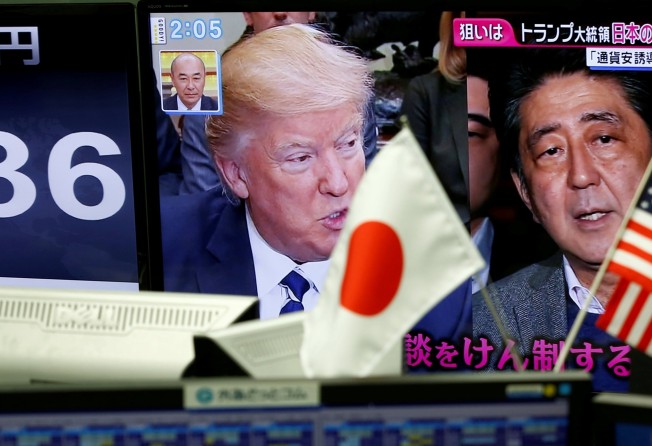What might a continued weak yen mean?
The US Treasury registered its continuing concern at ‘the persistence of the large trade imbalance between the US and Japan’ while the US President himself noted how his country ‘has suffered massive trade deficits at the hands of Japan for many, many years’

A flurry of recent decent economic data leaves Japan’s economy entering the New Year with a spring in its step.
Whether that sprightliness is maintained may partly depend on which direction the yen takes in 2018. A weak yen might suit Tokyo’s economic and monetary policy objectives but the risk is that Japan’s currency rises.
A weak yen enhances the competitive advantage of Japan’s export sector by making yen-denominated products cheaper for overseas buyers. It also exercises an inflationary influence on the prices of foreign goods imported into Japan, thus helping the Bank of Japan’s (BOJ) pursuit of higher inflation.
A stronger yen would have the opposite effects.
At first sight the idea of the yen materially strengthening this year might seem odd, given that the BOJ currently remains committed to ultra-accommodative monetary policies when other major central banks, such as the US’ Federal Reserve, are already moving to gradually normalise policy settings.
But if the yen weakness is predicated on the prolongation of BOJ ultra-accommodativeness, then the Japanese currency would surely react strongly to any hint that Japan’s central bank is rowing back from that stance or any perception by markets that robust Japanese economic data doesn’t require such loose monetary policy settings.
Although Japan’s core inflation is just 0.9 per cent, it could be argued that after five successive quarters of economic expansion, with a jobless rate of just 2.7 per cent and a jobs-to-applicants ratio at its highest level since 1974, Japan could afford the BOJ to slightly take its foot off the gas.
At the moment though, BOJ Governor Haruhiko Kuroda remains wedded to the central bank’s current course, saying on December 26 that the Bank of Japan would maintain its “powerful” monetary backing for the Japanese economy given that the BOJ’s 2 per cent inflation target remains a long way off.
Yet on Saturday, Japan’s Chief Cabinet Secretary Yoshihide Suga felt it necessary to emphasise his view that it’s “too early” to debate an exit from the BOJ’s stimulus programme.
Suga may be attempting to end such a debate even before it’s really begun to avoid unwelcome consequences such as the risk of a stronger yen.

In 1998, the Nobel Prize-winning economist Paul Krugman wrote that the way for the Bank of Japan to make monetary policy effective was “for the central bank to credibly promise to be irresponsible”.
It could be argued that the BOJ’s continuing rigid adherence to ultra-accommodative monetary policy settings in the face of broader robust economic performance represents Krugman’s suggestion in practice, with the ultra-loose policymaking the yen less attractive in its wake.
Consequently, any hint of a relaxation of that approach might well have the effect of strengthening the yen which is not what Japan’s policymakers, including Suga, would wish to see at the current juncture.
But there’s an added complication.
The currency market already seems to be carrying a sizeable and, some might argue stale, short yen position into 2018, in expectation that the Japanese currency will remain weak. For example, data released on Friday for the week ending December 26 by the US’ Commodity Futures and Trading Commission showed International Monetary Market speculators holding a net long position of US$12.8 billion versus the yen.
The US dollar, in a broad sense, had a poor 2017 and if that situation continues into the New Year there may come a point when traders start to wonder whether continuing to run a large short yen position in isolation versus the greenback still makes sense
If complacency about yen weakness proves misplaced, it could culminate in a materially stronger Japanese currency as the structural position starts to unravel.
But it’s not just yen-specific factors which could overturn the currency applecart.
The US dollar, in a broad sense, had a poor 2017 and if that situation continues into the New Year there may come a point when traders start to wonder whether continuing to run a large short yen position in isolation versus the greenback still makes sense.
It’s also possible that with more robust economic data emanating from Japan, the Trump Administration might take umbrage if the yen remains weak versus the US dollar, providing Japanese manufacturers with a continued advantage over their US competitors.
In October the US Treasury registered its continuing concern at “the persistence of the large bilateral trade imbalance between the United States and Japan” while the following month President Trump noted how “the United States has suffered massive trade deficits at the hands of Japan for many, many years.”
With Japan entering January with an improved economic performance resting on a bed-rock of ultra-accommodative monetary policy and a competitively-priced local currency, Japanese policymakers may wish for more of the same in the coming months. But the risk is that the yen strengthens in 2018 and undermines those New Year hopes.